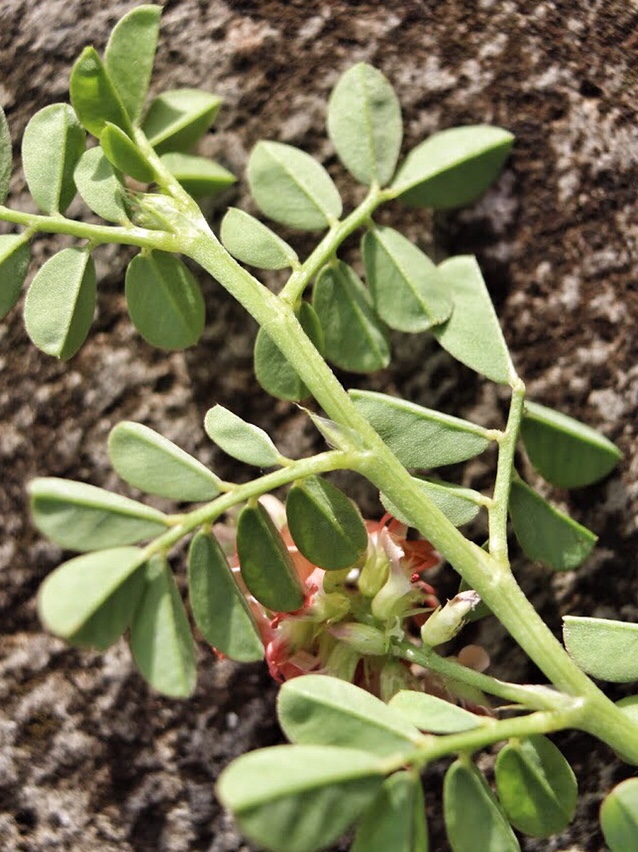(n.) a small leaf-like appendage to a leaf, typically borne in pairs at the base of the leaf stalk
In the absence of any obvious fruit, a modest appendage saves the day.
My first inclination was to greet this as creeping indigo, Indigofera spicata, but it appeared smaller and softer and somehow more appealing. Of course, that could all be explained by simply being young and fresh. I just recently invested $44 in the Guide to Florida’s Vascular Plants, however, and I’ve been a bit eager to dive into a dichotomous key rather than flip through the single field guide that I have for this area. And so, feeling both hopeful and smug, I poke, prod, and photograph the plant.
First, the flowers:

Then, the leaves (as much as I am able to get with my extension tubes still on):

I observed the basics- flower shape indicates family Fabaceae. Its similarity to an already familiar plant suggests the genus Indigofera. The leaf arrangement is alternate. The leaf type is pinnate. No obvious hairiness, no distinct fragrance, no milky sap.
And then I head home to my fat, complicated text just to be immediately humbled to learn that there nine different species of Indigofera known in Florida, and that the leaves and flowers rule out only one single species to start.
Not Species #9 (I. pilosa), because the leaves are not 3-parted.
The next step in the key is to observe the fruits… not immediately obvious in my photos. So I head back to the single flower in bloom (conveniently cuddled up against a lamppost only a block away) and search again for fruits… to no avail. Whether immature or unsuccessful, my new acquaintance has apparently not yet reproduced. But all is not lost, because further down, the key offered some helpful options.
Not Species #8 , #7, or #6 (I. hirsuta, I. colutea, or I. trita), because the stems are not obviously hairy, even under magnification.
The next step flusters me. I am a hideously literal person – which usually works in my favor in science. When confronted with the question of whether the plant is “erect” or “prostrate”, I don’t get the giggles- I get befuddled. Of course, it’s erect! Look at the flower stalk, sticking up in the air. Eventually, I remember that the terms apply to the leaves, not the flowers, and cross two more off the list.
Not Species #5 or #4 (I. suffruticosa or I. tinctoria), because the leaves are definitely not climbing or upright.
Two-thirds of the list eliminated, but now there’s a dilemma. According to the key, the distance between fruits (which I still don’t have) is the best variable to compare. Luckily, it also describes the stipule shapes for each. Unluckily, none of my pictures show the stipules. Another trip back to the plant… and after careful comparison of deltoid, lanceolate, and subulate:

Not Species #3 (I. miniata), because the stipules are significantly wider at the bottom than the top.
So now, two species remain. Indigofera caroliniana would have short, stumpy indehiscent fruits less than a centimeter long, each containing 2 or 3 seeds. Indigofera spicata would have longer fruits with an apparent seam and several seeds. I, however, have no fruits at all.
The key, with all of its beautiful words, can do no more for me. My field guide only shows one of the two species. It’s time to resort to the internet. A quick glance at the photo gallery from the website of the Atlas of Florida Plants makes it obvious that it is:
Not Species #2, because I. caroliniana is clearly not prostrate, nor does it have densely packed racemes like my individual does.
Which means… this particular plant is Indigofera spicata, otherwise known as creeping indigo– the very species I first guessed it to be, but hoped it wasn’t. Not that there’s anything wrong with creeping indigo, but there’s a simple joy to adding another species to the roster in my head (and this website). I may have missed out in that regard, but I gained in another. Thanks to this evening’s delights, I know more than I did yesterday.
- I know there’s 9 known species of Indigofera in Florida.
- I know only one has 3 parted leaves.
- I know that stipules and hair matter.
Today, I found satisfaction in the discovery process. Who knows what I’ll find tomorrow?
***Update*** I revisited the plant for 3 days before I found fruits to confirm the identification. Here they are:

Indigofera spicata fruits

Indigofera spicata seeds (4-6 per fruit)



One thought on “stip·ule”